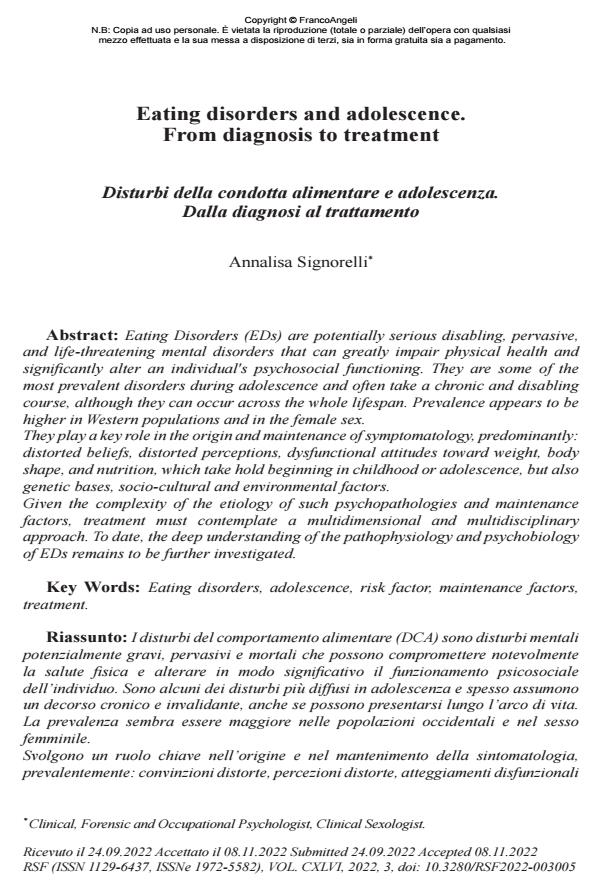Eating disorders and adolescence. From diagnosis to treatment
Titolo Rivista RIVISTA SPERIMENTALE DI FRENIATRIA
Autori/Curatori Annalisa Signorelli
Anno di pubblicazione 2022 Fascicolo 2022/3
Lingua Inglese Numero pagine 23 P. 81-103 Dimensione file 226 KB
DOI 10.3280/RSF2022-003005
Il DOI è il codice a barre della proprietà intellettuale: per saperne di più
clicca qui
Qui sotto puoi vedere in anteprima la prima pagina di questo articolo.
Se questo articolo ti interessa, lo puoi acquistare (e scaricare in formato pdf) seguendo le facili indicazioni per acquistare il download credit. Acquista Download Credits per scaricare questo Articolo in formato PDF

FrancoAngeli è membro della Publishers International Linking Association, Inc (PILA)associazione indipendente e non profit per facilitare (attraverso i servizi tecnologici implementati da CrossRef.org) l’accesso degli studiosi ai contenuti digitali nelle pubblicazioni professionali e scientifiche
Eating Disorders (EDs) are potentially serious disabling, pervasive, and life-threatening mental disorders that can greatly impair physical health and significantly alter an individual's psychosocial functioning. They are some of the most prevalent disorders during adolescence and often take a chronic and disabling course, although they can occur across the whole lifespan. Prevalence appears to be higher in Western populations and in the female sex. They play a key role in the origin and maintenance of symptomatology, predominantly: distorted beliefs, distorted perceptions, dysfunctional attitudes toward weight, body shape, and nutrition, which take hold beginning in childhood or adolescence, but also genetic bases, socio-cultural and environmental factors. Given the complexity of the etiology of such psychopathologies and maintenance factors, treatment must contemplate a multidimensional and multidisciplinary approach. To date, the deep understanding of the pathophysiology and psychobiology of EDs remains to be further investigated.
I disturbi del comportamento alimentare (DCA) sono disturbi mentali potenzialmente gravi, pervasivi e mortali che possono compromettere notevolmente la salute fisica e alterare in modo significativo il funzionamento psicosociale dell’individuo. Sono alcuni dei disturbi più diffusi in adolescenza e spesso assumono un decorso cronico e invalidante, anche se possono presentarsi lungo l’arco di vita. La prevalenza sembra essere maggiore nelle popolazioni occidentali e nel sesso femminile. Svolgono un ruolo chiave nell’origine e nel mantenimento della sintomatologia, prevalentemente: convinzioni distorte, percezioni distorte, atteggiamenti disfunzionali nei confronti del peso, della forma del corpo e dell’alimentazione, che prendono piede a partire dall’infanzia o dall’adolescenza, ma anche basi genetiche, fattori socio- culturali e ambientali. Data la complessità dell’eziologia di tali psicopatologie e dei fattori di mantenimento, il trattamento deve contemplare un approccio multidimensionale e multidisciplinare. Ad oggi, la comprensione profonda della fisiopatologia e della psicobiologia dei DCA resta da approfondire.
Parole chiave:disturbi alimentari, adolescenza, fattori di rischio, fattori di mantenimento, trattamento.
Annalisa Signorelli, Eating disorders and adolescence. From diagnosis to treatment in "RIVISTA SPERIMENTALE DI FRENIATRIA" 3/2022, pp 81-103, DOI: 10.3280/RSF2022-003005